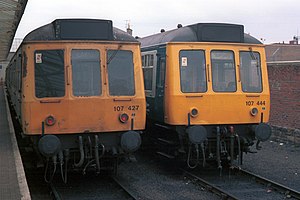British Rail Class 107
| British Rail Class 107 (Derby short heavyweight) |
|
|---|---|

Units 107 427 and 107 444 at Largs in April 1984
|
|
| In service | 1960–1991 |
| Manufacturer | BR Derby Works |
| Constructed | 1960 |
| Number built | 26 sets (78 cars) |
| Formation | 3-car sets: DMBS-TSL-DMCL |
| Capacity | DMBS: 52 second-class TSL:71 second-class DMCL: 12 first-class, 53 second-class |
| Operator(s) | British Rail |
| Specifications | |
| Car length | 58 ft 1 in (17.70 m) |
| Width | 9 ft 3 in (2.82 m) |
| Height | 12 ft 4 in (3.76 m) |
| Maximum speed | 70 mph (113 km/h) |
| Weight | DMBS: 35.0 tonnes (34.4 long tons; 38.6 short tons) TCL: 28.5 tonnes (28.0 long tons; 31.4 short tons) DMCL: 35.5 tonnes (34.9 long tons; 39.1 short tons) |
| Prime mover(s) | Two BUT 6-cylinder diesels per power car |
| Power output | 600 bhp (447 kW) per set, 300 bhp (224 kW) per power car, 150 bhp (112 kW) per engine |
| Transmission | Mechanical: 4-speed epicyclic gearbox |
| Safety system(s) | AWS |
| Coupling system | Screw-link, British Standard gangways |
| Multiple working | Blue Square |
| Track gauge | 1,435 mm (4 ft 8 1⁄2 in) |
The British Rail Class 107 diesel multiple units were built by the Derby Works of British Railways and were introduced in 1960. The class looked similar to the later Class 108 units, but were heavier - having been built out of steel.
The Class 107s were used in the Scottish Region, where the Class remained for its service life. When new, a number were used on Dundee/Arbroath services. In later years, they were used almost exclusively on services radiating from Glasgow Central to such destinations as Barrhead, East Kilbride, and Kilmacolm, and - prior to electrification - on Glasgow/Ayrshire services (especially Largs). Most were withdrawn from service by 1991.
Many of the units went into departmental use after being withdrawn from passenger use. The class suffered from a structural problem, however, which could result in the bodies separating from the chassis under heavy braking.
Originally, there were no fixed set formations, but eventually, sets were numbered as 107425-449 in DMBS order (the DMCLs & TSLs were formed into the sets at random). Renumbered to 107725-749 in 1988 to avoid confusion of set numbers with new 156 units which also had 4xx numbers. Renumbered again to 107025-049 about 1990 to avoid similar confusion with new class 158s numbered in 7xx series.
For coupling codes see British United Traction
Several examples of the class have entered preservation.
...
Wikipedia
